Guitar licks are all about expressing emotion, adding flair, and connecting different musical ideas with a solid piece.
They can transform a simple chord progression into an entire journey.
To use guitar licks effectively, you’ve got to know all about the right techniques, understand their musical context, and know how to blend them into your playing.
That’s why, in today’s “What is a Guitar Lick” post, we’re breaking down:
- What is a guitar lick (basic concepts) ✓
- Creating your own licks ✓
- Differences between a guitar lick and riff ✓
- Various techniques like hammer-ons and pull-offs ✓
- The role of scales like minor pentatonic and blues ✓
- Incorporating licks into solos ✓
- Expert tips so you’ll be able to play riffs/licks like a pro ✓
- Examples of licks in different music genres ✓
- Advanced soloing techniques ✓
- Music variations for any music style ✓
- Much more about lick/riff essentials ✓
By the end of this article, you’ll have a solid understanding of guitar licks and riffs, so you can create and use them effectively in your own music.
This way, you can enhance your guitar playing, give your performances some emotional expression, and master the fretboard like a professional.
Whether you’re jamming at home, recording in a music studio, or performing live, the skills you’ll learn here will help you shine as a guitarist/music enthusiast.
Side note, usually our blogs are tailored strictly to digital music producers, but this one is for my fellow guitar players (mainly).
So, let’s dive in so you can answer the question, “what is a guitar lick?”
Table of Contents
What are Guitar Licks? Breaking it Down

Guitar licks are short musical phrases used by guitarists to:
- Express emotion
- Brighten up melodic ideas
- Demonstrate different skills
Unlike full solos or extended passages, a guitar lick is typically a few bars long and can be easily integrated into various musical settings.
Guitar licks often utilize techniques such as bends, vibrato, and slides 一 making them invaluable in the world of expression.
Understanding guitar licks is essential for any aspiring guitarist as they are foundational in popular genres, from blues to rock and everything in between.
Guitar licks are not just random notes…
They’re carefully crafted to fit into a musical context, so you can pretty much think of a them as the building blocks for larger guitar solos or instrumental bridges in songs.
NOTE: A guitar lick often emphasizes the notes of the underlying chord progression, which allows guitarists to highlight specific notes within a scale.
Bottom line, mastering the use of guitar licks can elevate your guitar playing and provide the perfect way to communicate more through your instrument.
Creating Your Own Licks
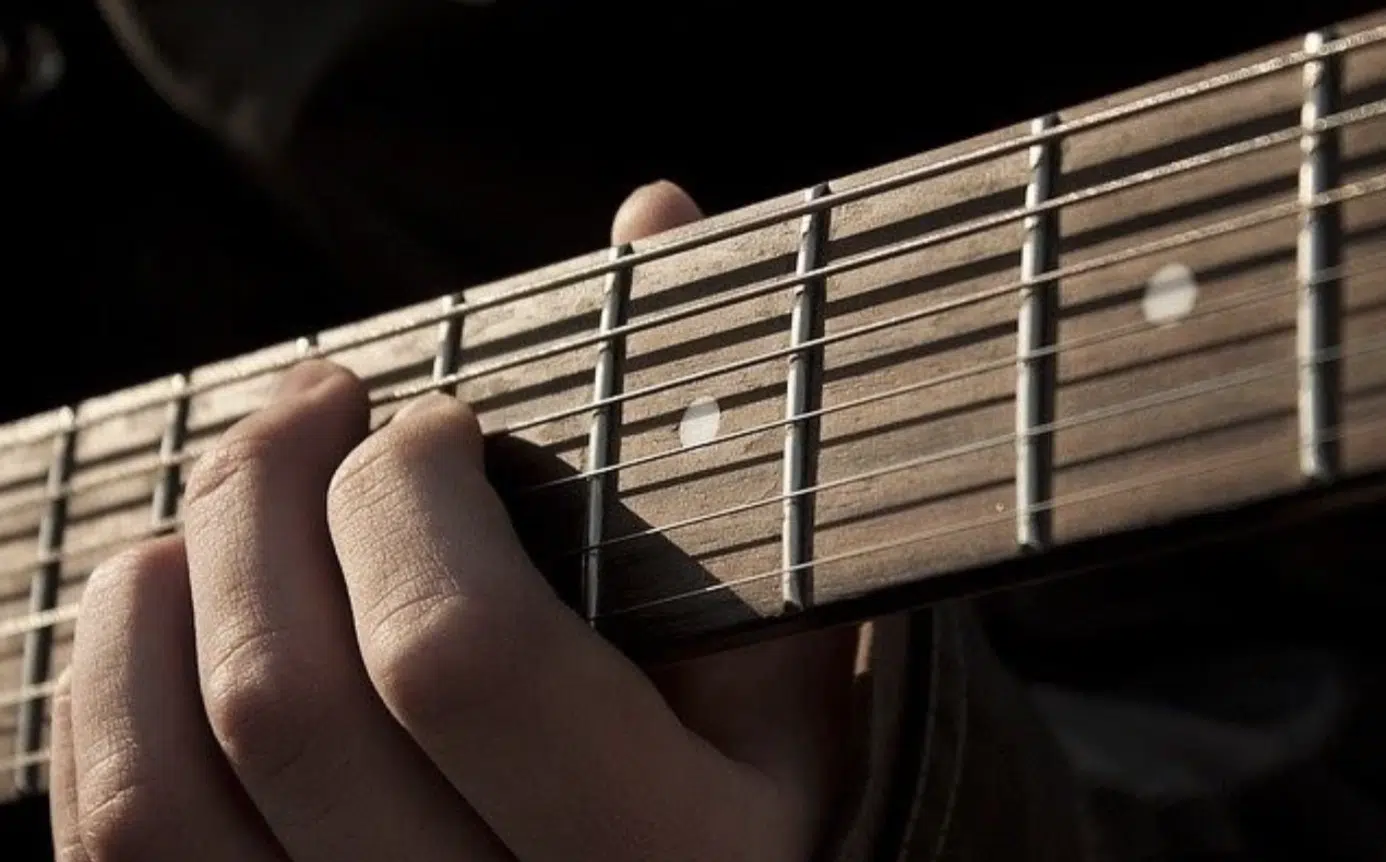
Creating your own guitar licks allows you to express your individual musical voice and style, and a great starting point is the minor pentatonic scale.
The minor pentatoninc scale is used for its versatility in various musical genres like rock, blues, and jazz (all the popular guitar-based genres).
For example, if you’re playing in A minor, the minor pentatonic scale would typically include the notes A, C, D, E, and G.
These notes are the perfect place to begin experimenting with creating licks that really get your listeners hooked.
Start by picking a root note (such as A) and follow with a stock pattern that might include a:
- Bend on the D
- Pull-off from E to D
- Slide from C back to A
This simple sequence uses just a few notes but incorporates fundamental guitar techniques to create a distinct musical phrase, so it’s not for nothing.
As you grow more comfortable, remember to include more advanced techniques like double stops or vibrato to add texture and emotion to your licks.
NOTE: Beyond the basic minor pentatonic, consider variations by adding additional notes to create a blues scale. In the A minor context, adding a flattened fifth (Eb) transforms your pentatonic scale into a blues scale.
It opens you up to new melody opportunities and a slightly more dissonant, gritty sound, which is typical of classic blues licks.
Make sure to practice this scale over different chord progressions to hear how these notes interact with the harmony.
What you learn will help you create licks that enhance the emotional impact you’re able to play around with and bring to the table.
Guitar Licks vs. Guitar Riffs: Key Differences
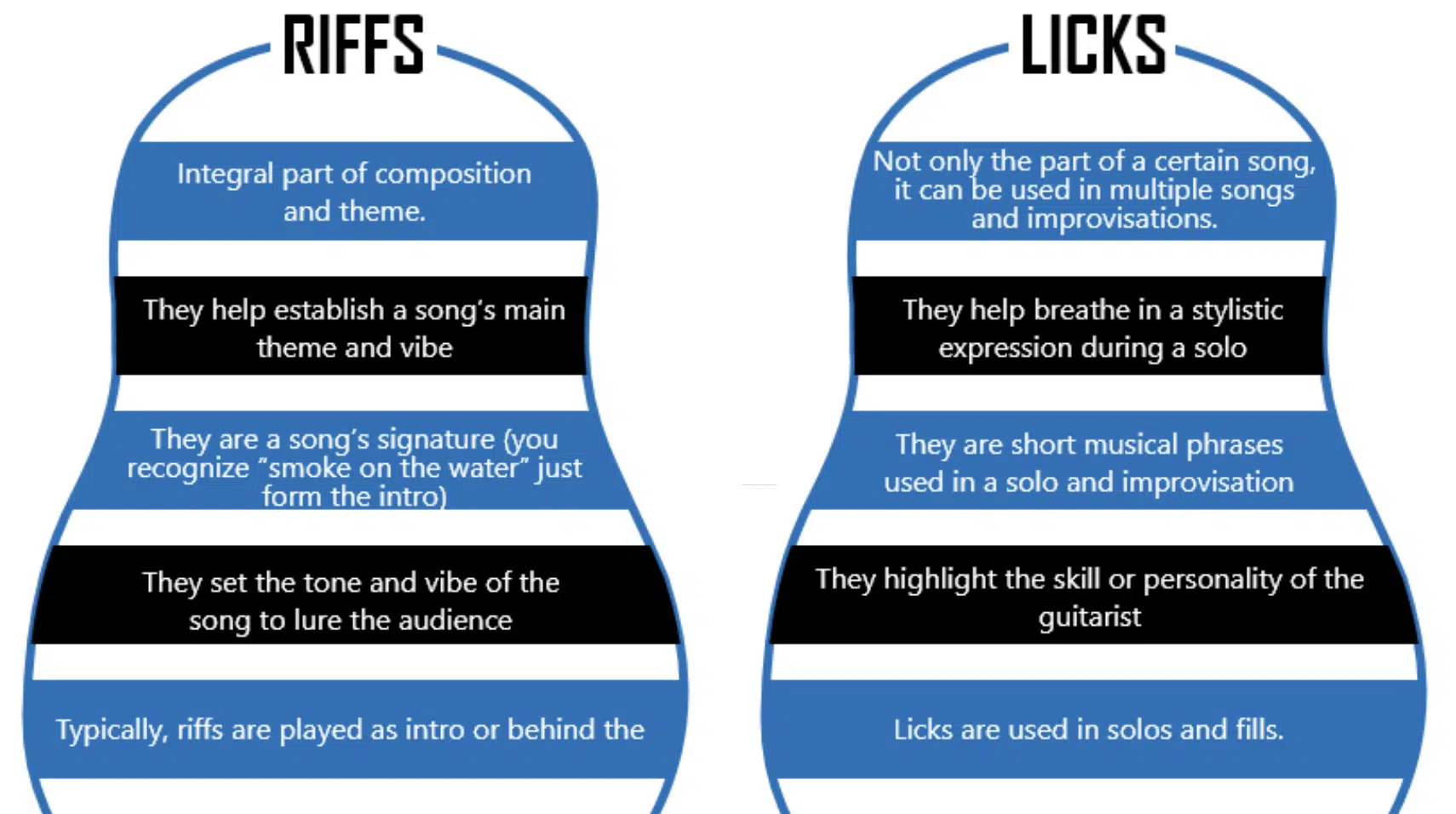
Guitar licks and guitar riffs are both essential elements of guitar playing, so you’ll need to really understand their key differences and roles to become a master guitarist.
A guitar riff is a repeated chord progression or refrain that forms a recognizable and rhythmic pattern that often defines the main song.
Guitar riffs can be heard as the main riff in songs like “Teen Spirit,” “Seven Nation Army,” or “Back in Black” by AC/DC, where the driving, punchy chords set the tone and pace.
Just remember that an effective riff not only captures the listener’s attention but also establishes the musical theme and mood of the song.
Guitar licks are generally shorter melodic phrases used to embellish or add complexity.
A guitar lick is usually integrated within a guitar riff or used during a solo to add some variation and expressiveness when people hear it.
- Guitar riffs provide a consistent and stable musical motif
- Guitar licks offer a moment of improvisation and edge that highlights creativity
For example, in Led Zeppelin’s song “Stairway to Heaven,” the guitar solo contains numerous licks that enhance the progression of the main guitar riff.
It adds layers of melodic texture and dynamic contrast to your track, which all guitar players will tell you is key.
Guitar riffs tend to repeat throughout the song 一 forming a solid song foundation that the rest of the song is often built around.
This repetition can make your guitar riff super easy to recognize and often becomes the defining element of the entire song (no joke).
On the other hand, guitar licks, while they can be repeated, are used more sparingly/strategically to make sure that each time it’s heard, it makes a strong impact.
Remember: the key difference in how guitar riffs and guitar licks function within music is that riffs create the memorable framework of the main song, and licks provide the intricate details that enhance and embellish the overall musical narrative.
-
Pro Tip: Examples of Popular Guitar Licks
One of the most famous examples of a guitar lick shaping a song is found in “Smoke on the Water” by Deep Purple, which is one of my favorites.
The opening riff (arguably one of the most memorable riffs in rock music history) serves as the main musical idea throughout the entire song.
The guitar lick played in this track uses a simple but effective sequence of notes that has captivated guitarists and audiences alike.
It really demonstrates how a guitar lick can anchor and define the entire song.
Eric Clapton and Stevie Ray Vaughan, masters of expressive guitar playing, often incorporated licks that were central to their music.
These licks not only complemented the underlying chord progressions but often escalated into the main musical idea of countless performances.
Short musical phrases like these licks packed a powerful punch of bluesy emotion and proved how dynamic guitar lick sounds can enhance an entire song.
They provide a certain depth and new layer of auditory appeal that enhances the listener’s experience and keeps them coming back for more.
By studying them, you can learn to play around with licks that are not only technically proficient but also emotionally powerful and unforgettable.
Guitar Lick Techniques & Tips
The techniques involved in playing guitar licks can vary widely 一 from simple finger plucking to more complex methods like sweep picking or tapping.
Each guitar technique offers a different sound and feel which helps guitarists express a range of emotions and styles, so let’s break them down…
-
Hammer-ons
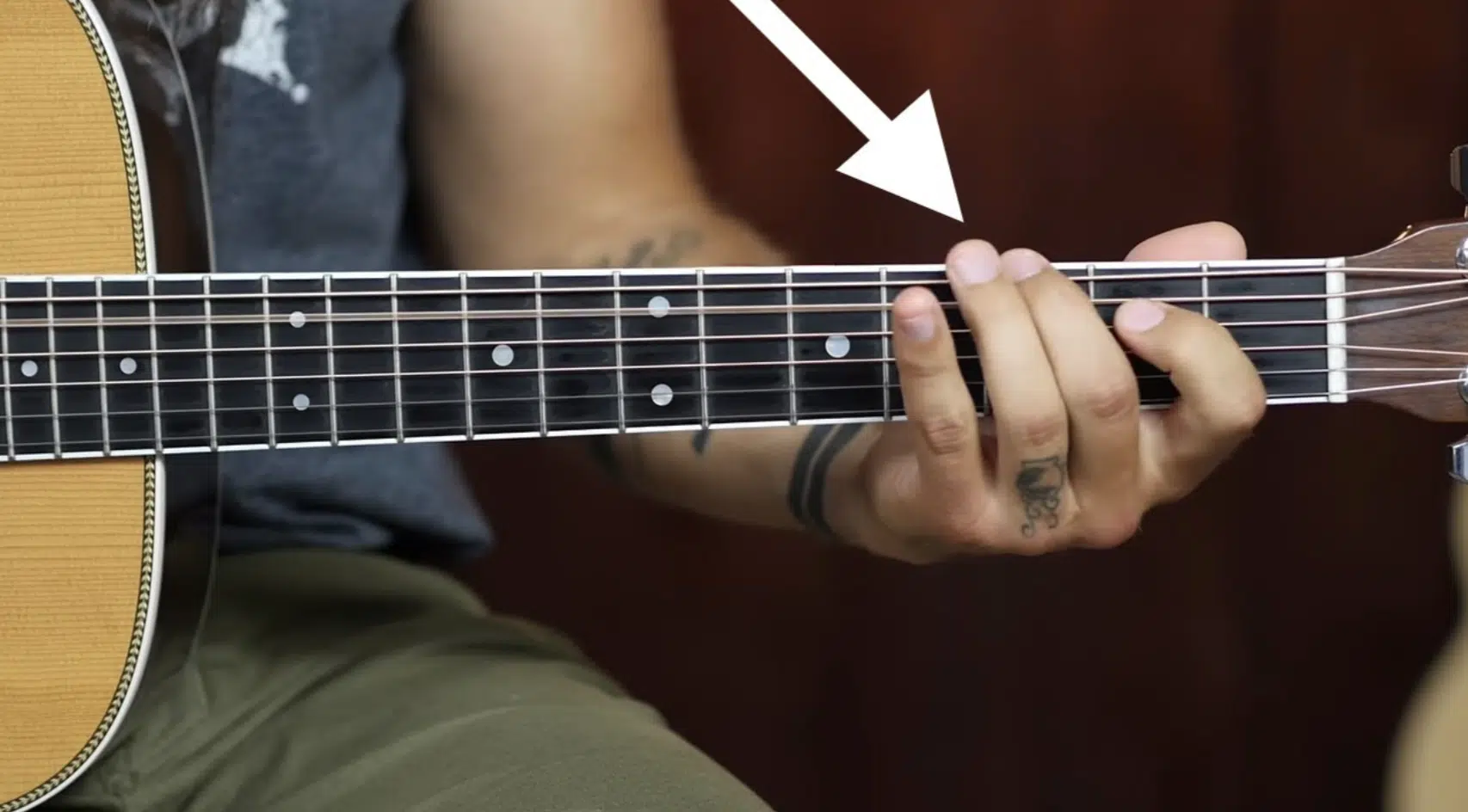
Hammer-ons are where you play a note and then hammer a finger onto a higher fret without plucking the string again.
This technique allows for a smooth, legato sound in licks.
For example, in a simple A minor pentatonic scale, you might play the note on the fifth fret of the E string and then hammer-on to the eighth fret of the same string.
This creates a fluid, connected sound that is often used in fast-paced solos and runs.
-
Pull-offs
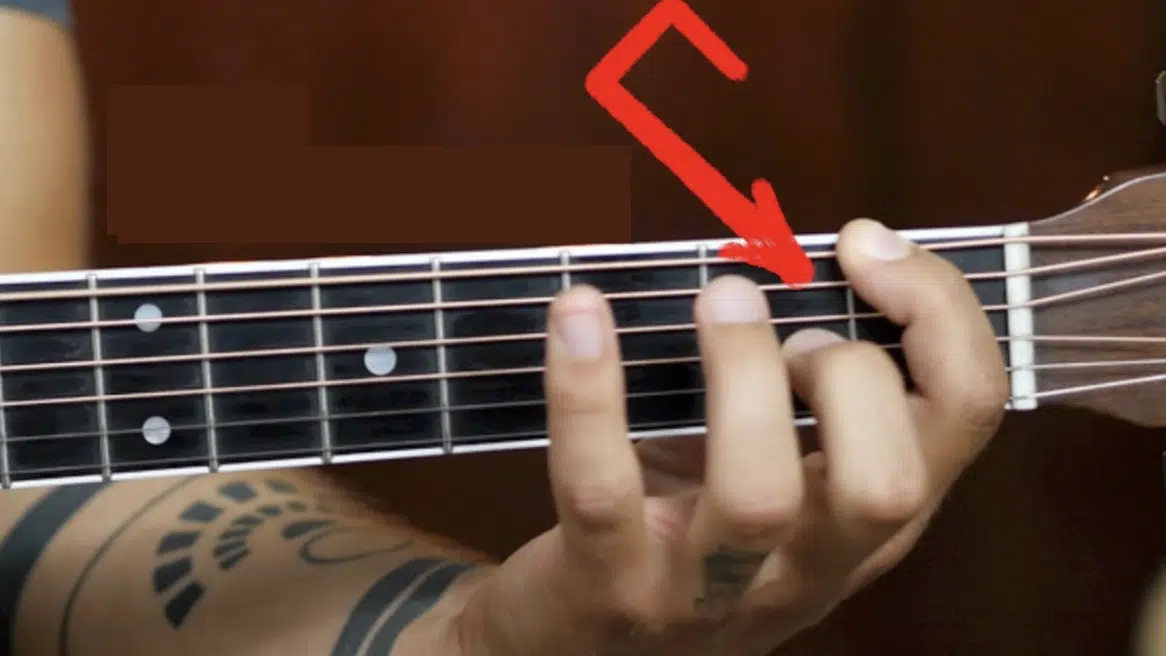
Pull-offs are the opposite of hammer-ons 一 you pluck a note and then pull your finger off to a lower fret to allow the lower note to ring out.
It also produces a legato effect, but with a descending pitch.
In the context of the A minor pentatonic scale (after doing a hammer-on from the fifth to the eighth fret on the E string), you could pull-off back to the fifth fret.
This hammer-on and pull-off combination is commonly used in licks to add speed and fluidity without requiring rapid picking, which is great.
-
Slide
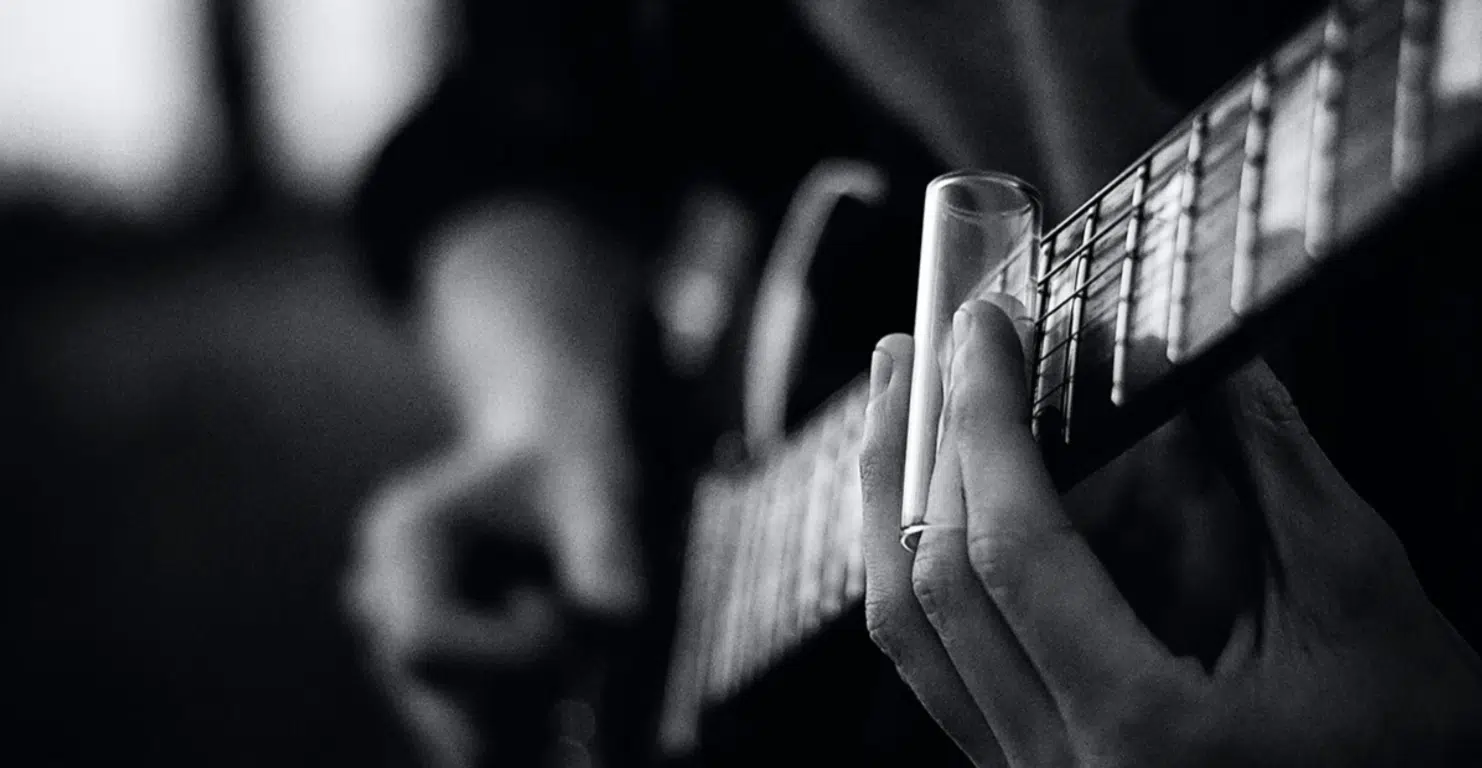
Slide is another expressive technique where you (as the name implies) slide your finger along the string from one fret to another.
This will form a smooth transition between single notes.
Slides can be performed either upwards or downwards and are effective in creating a wailing sound that is particularly popular amongst blues players and rock genres.
For instance, sliding from the fifth to the seventh fret on the G string within an A minor context can add a bluesy feel to your lick.
-
Bending
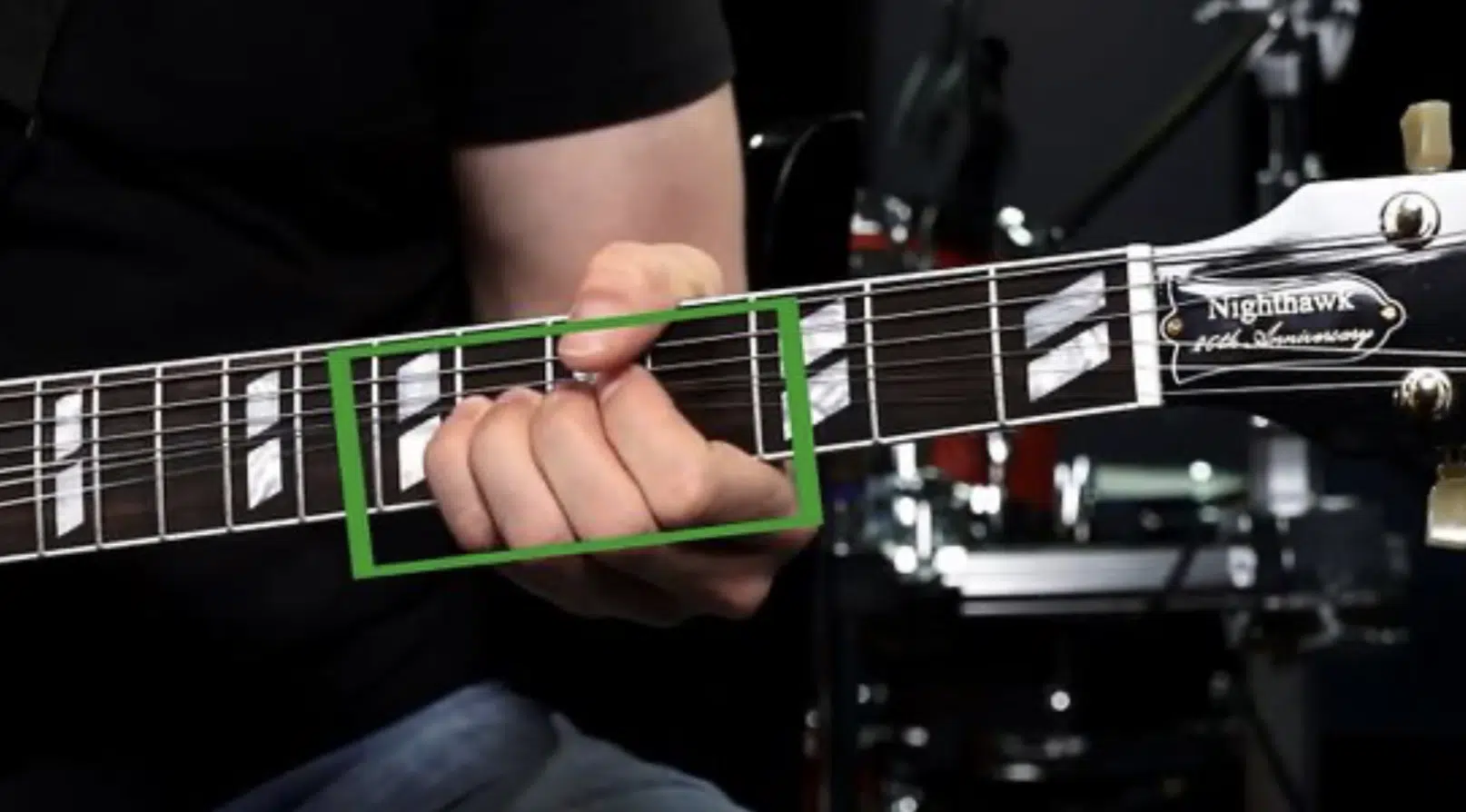
Bending involves pushing the string upwards/downwards to raise the pitch.
It’s often used to reach a target note that fits with the underlying chord or to add emotional impact.
For example, you might be bending the seventh fret on the G string up a whole tone in the A minor scale, to hit the pitch of the note normally played at the ninth fret.
Bends can add a vocal-like quality to guitar licks 一 making them more expressive, immersive, and impactful.
Pro Tip: Power chords, typically played as a two-note chord consisting of the root note and its fifth, are a staple in rock music because they deliver a full, robust sound.
By incorporating power chords into your riffs and transitions, you can amplify the energy and create a more impactful guitar presence.
If you want to learn all about power chords, we’ve got you covered.
Creating Memorable Musical Phrases
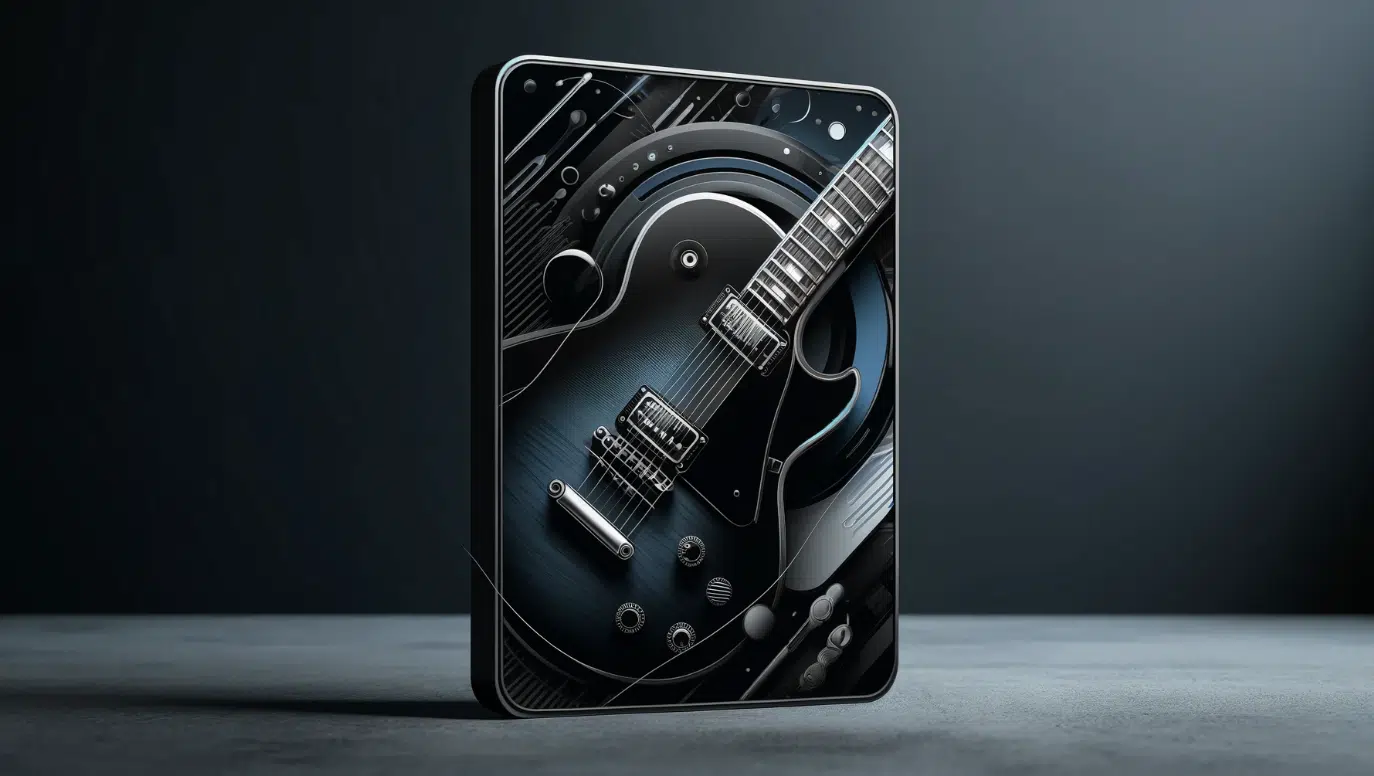
The creation of memorable musical phrases means you’ve got to use chord progressions, chords, and individual notes like a veteran musician.
Chord progressions provide the harmonic foundation over which licks are played; setting the emotional tone and guiding the melody flow of the licks.
For example, a chord progression like I-IV-V in the key of E (E, A, B) gives you a classic blues structure that invites expressive, soulful licks.
The choice of chords and the specific notes played when you’re creating licks can dramatically alter the feel and impact of the phrase.
By emphasizing certain notes (such as the root, third, or fifth of the underlying chord) a guitarist like yourself can create a sense of resolution or tension within their licks.
Adding passing tones or chromatic notes can also introduce complexity and intrigue 一 making your licks more captivating and memorable.
The rhythmic placement of notes within a guitar lick also plays a key role…
A well-placed note, whether played on the beat or syncopated, can make a phrase stand out (aka, people will definitely stop and listen).
Experimenting with different rhythmic patterns and note durations, such as staccato or legato playing, adds variety in each lick.
It can help you create licks that listeners connect with and can’t forget.
Guitar Licks: Techniques For Innovative Guitar Players
Mastering guitar licks requires a blend of technical skill, hustle, and musical intuition. As you develop your playing skills, remember licks are not just about playing notes but about expressing feelings/connecting with your audience. This is what it’s all about.
-
Innovative Guitar Solos
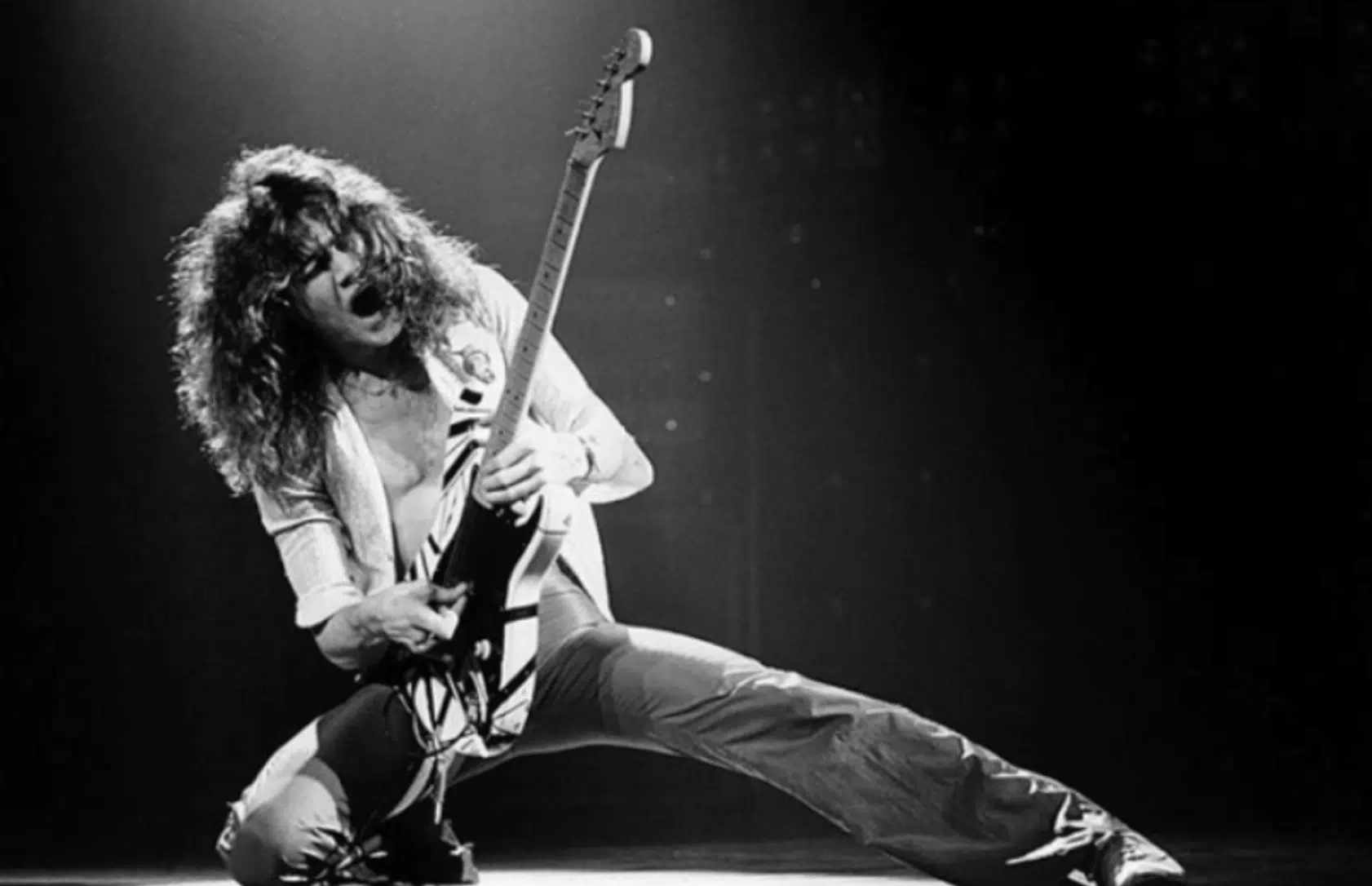
If you’re looking for a new musical idea, innovative guitar solos can completely change the game and help get you inspired in no time.
To create show-stopping guitar solos, you should use different scales and techniques that can lead to unique and memorable musical expressions.
For instance, blending the minor pentatonic scale with elements of the major scale can add unexpected brightness to a typically sadder/darker lick.
Let’s just pretend we’re considering a guitar lick in A minor pentatonic…
By incorporating a C# (the major sixth from the A major scale), you can introduce a surprising element that can change the entire emotional tone of the solo.
Another method is to experiment with modal playing 一 which involves using different modes to create specific atmospheres within your solos.
Utilizing the Mixolydian mode over dominant seventh chords, for instance, can infuse a solo with a bluesy, yet slightly unresolved feeling (perfect for genres like blues-rock).
These modes will help you create intriguing guitarists licks that rise above the rest, thanks to their distinct tonal flavors.
This will, in turn, help your solos be both innovative and true to your unique style.
-
Incorporating Licks into Your Own Solos

Incorporating licks into your guitar solos effectively can completely transform an improvised solo into a mind-blowing musical moment in time.
To begin, select a few licks that resonate well with the tonal quality and emotional feel of the song you are working on.
For example, if you are creating a guitar solo in a blues track, choose licks that include bending and vibrato to emphasize the bluesy feel.
Incorporating a great lick starts by slipping them in at pivotal points in your guitar solo…
Maybe to launch the solo with a strong statement or to bridge a transition between different chord progressions.
It ensures that each guitar lick enhances the narrative flow of the solo 一 keeping your listeners engaged throughout and not bored at all.
Also, consider the dynamic range of your lead guitar solo by using licks that vary in intensity and pitch.
A well-placed short phrase (short musical phrase) can serve as a call-and-response element within your solo, creating a dialogue between the more intense passages.
It will make your song feel more organic and spontaneous, which is always good.
Additionally, experiment with stringing a few licks together to build up a climax or using them to gracefully exit the solo, reverting back to the main theme of the song.
By placing these licks within your solos strategically, it ensures that all the single note lines carry emotional weight and contribute to a more memorable guitar solo.
Remember, it’s all about getting in people’s heads and setting up residence.
What is a Guitar Lick: Final Thoughts
Really understanding the answers to the question, “what is a guitar lick?” is make-or-break for guitarists looking to enhance their skills.
Not only answering what is a guitar lick, but how it differs from a guitar riff as well.
If you’re looking to add that emotion and expression needed for professional guitarists to get noticed, there’s no better way than guitar licks.
I mean, what is a guitar lick if not a way to connect more deeply with the music and give your audience something to really hang on to/remember.
For the music producers who stuck around until the end of this article, these legendary, industry-favorite Free Guitar Loops are for you.
It includes 7 free, show-stopping free guitar loops + 70 audio & MIDI stems for ultimate flexibility and freedom.
Each guitar loop was recorded by professional guitar players, and modeled off the styles of the biggest hit songs in modern music, so they’re truly epic.
They’re designed to inspire and elevate your tracks to a whole new level.
Remember, whether you’re producing digital tracks or playing live, engaging with your guitar and playing with your whole heart makes a significant difference.
It’s not just about the notes you play, but how you feel them that truly shapes their impact.
Until next time…







Leave a Reply
You must belogged in to post a comment.